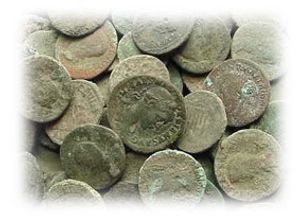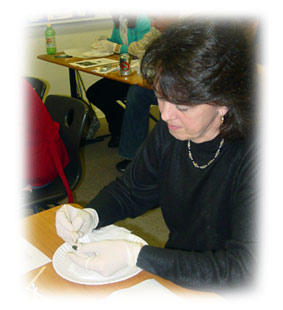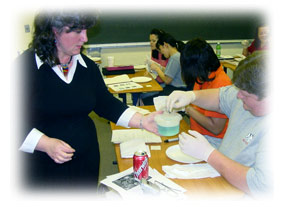
For a few hours recently, 23 Catawba College students became amateur numismatists of Roman coinage and they never even left their classroom.
The history of the ancient western world came to life for this group of Lifelong Learners as they each were given an unique opportunity to clean, identify, date, evaluate, and keep a one-of-a-kind Roman coin at least 1,800 years old. This coin activity was one of the final lessons in a March 31 class taught by classical scholars Jim and Andrea Brewer of Salisbury. Jim is trained as a Bronze Age archaeologist and Andrea is a Classical literature and languages specialist.
;The Brewers set the tone for their students with a hand-out showing details of various Roman coins and comments about how coins are made using a die and a punch. It is estimated that, on average, 200 million coins were minted each year for over 300 years. They described features found on coins ranging from the time of the Persian Empire, during the life of Alexander the Great, the Roman Republican period, the Empire period and finally to the Constantine and Byzantine periods.
“All coins are individuals,” Andrea Brewer explained. “All were hand struck and no two are alike. Each depends on the heat of the metal and the accuracy of the strike. They weren’t churned out by the thousands by machines.
“The Romans liked bronze coins, while the Greeks preferred silver,” she said, noting that bronze is actually a combination of metals. “During the period of the Republic, they didn’t want any living person featured on their coins, but that changed during the last little bit of the Roman Republic when Julius Caesar’s likeness was imprinted on Roman coinage. Following him was the Emperor Augustus, thereafter, you began to see the likeness of the Roman Emperor on the front, or “obverse,” of Roman coins with some sort of propaganda message or symbol on the back, also called the ‘reverse.’ Even members of the emperor’s family appeared on coins, sometimes in various stages of their development. The message was one of succession – sons following the footsteps of their fathers, therefore these coins are called Roman Imperials.
“During the Constantine period—the time of the Late Empire--- the likenesses of Roman gods and goddesses stopped -- there was no more of that, you began to see coins produced using traditional Christian religious symbols,” Andrea Brewer concluded.
 ;
;
Anticipation among the students in the classroom began to build as the Brewers passed out coin cleaning supplies – rubber gloves, Q-tips, cleaning rags, paper plates and towels. Some donned gloves as soon as they received them and sat waiting expectantly. On a table against the classroom wall sat plastic bowls of Dawn detergent and water, lemon juice, boxes of baking soda, distilled water, and various chemical cleaning agents. At the professors’ desk was a small plastic container in which several dozen, very dirty coins soaked in distilled water.
Andrea Brewer explained how to properly clean old coins, noting a long soak in distilled water was the easiest and gentlest way to “start pulling out the debris” of the ages. “I’m not that patient,” she joked, and explained that her preferred method of cleaning was to soak a coin in “plain old olive oil,” followed by a light swabbing with a Q-tip.
“You need just enough oil to cover the coin,” she said. “It’s a good dirt lifter and doesn’t hurt the coin. It adds a sort of protective grease layer and doesn’t strip the patina which can range from black to blue to green.”
A more intense cleaning method involves dipping the coin in a mixture of lemon juice and baking soda. And, for the very impatient or frustrated coin cleaner, there are a variety of tried and tested “stronger” cleaning chemicals, she added.
To make the coin exercise fair to the students, the Brewers held a lottery of sorts. Each student was given a number and as those numbers were randomly drawn from a manila envelope and called out, they came forward one by one to lift a coin from the distilled water.
“Are you sure it’s not a dime? Are you sure it doesn’t say ‘In God We Trust?’ ” joked sophomore Mike Buckworth of Concord as he carried the coin he had selected back to his desk. Then, all joking aside, he set to work, bringing his coin for a dip in the foaming lemon juice and baking soda mixture. Shortly, he could be heard reporting to several classmates as he fitted it into a mylar coin case, “It’s a Christian coin.”
 ;
;
Andrea Brewer affirmed Buckworth’s report. “It’s a Constantine coin with beautiful attributes.” Then, she was off to examine the coin of junior Margaret Sawyer of Concord who claimed hers showed the likeness of Romulus and Remus on its reverse side.
“Jim, I think we’ve got one,” Andrea called out to her husband as she held Sawyer’s coin. This coin was identified by the couple to be a very special issue, celebrating the change from Rome to Constantinople as the seat of the empire---a rebirth of Rome, so to speak. Because the date of the shift of the capital to Constantinople dates to 324 AD, they were able to attribute the minting of this coin to the same year with reasonable accuracy.
A frustrated student, senior Derek Tolley of Huntersville, tossed his coin into the chemical cleaning tray when his attempts at gentle cleaning were stymied. “It has lasted 2000 years, do you think some Tarnex is going to damage it?” As he wiped it clean, he could discern its image. He compared it to sample coins show in a reference book and moments later, he announced to the Brewers: “Fourth Century Constantine, 307 A.D.”
And the cleaning continued through the class period and the sounds of enthused and enlightened students could be heard as they wiped their way through the grime of centuries.
“That is really cool,” one student said.
“I think if it was soaked a while it might come out,” another student reasoned.
“Okay, I’m not going to sell it quite yet,” a smiling student told Jim Brewer as she placed her cleaned coin in a mylar case.
*** The Brewers conducted a similar hands-on exercise with the 3rd and 4th grade students at Salisbury Academy on April 1, 2005.***
